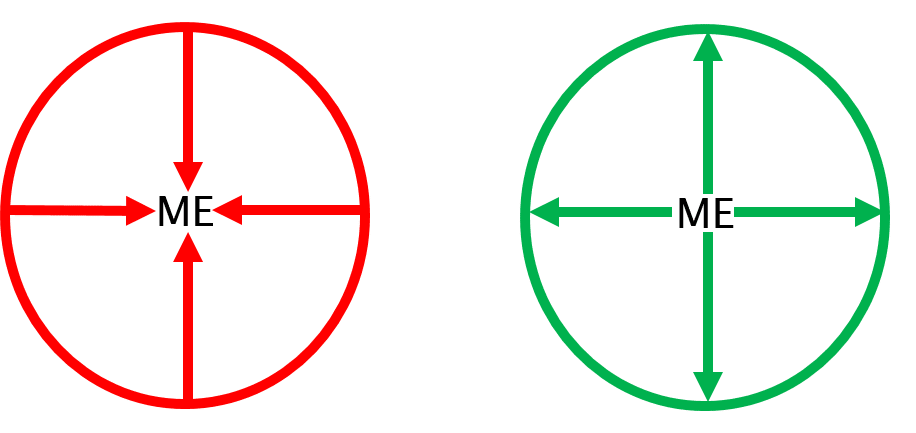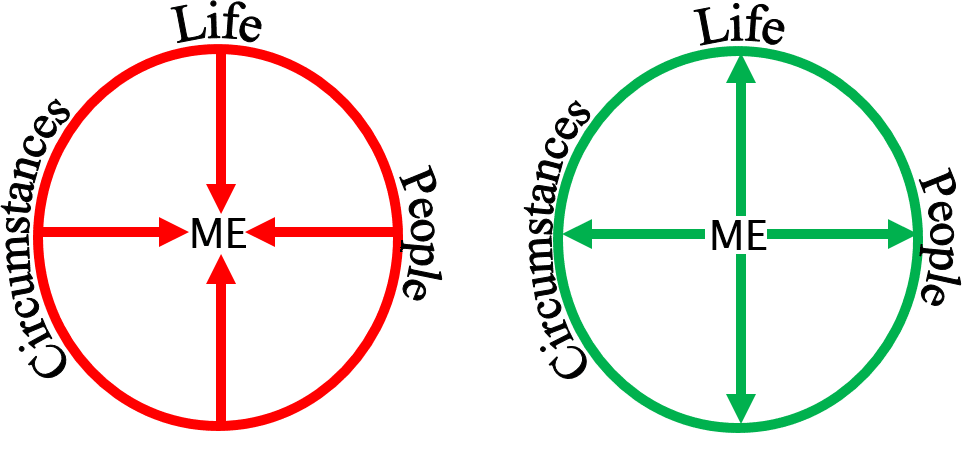Isn't it fun to be around someone who is complaining? Of course, it isn't! Complaining is a simple way to show how selfish we are - it's all about ME!
Too often, we are blind to the "all about ME" attitude. And it helps to have a tool to remind us when we are doing it. It's also great to have a tool that helps others discover their complaining spirit and how they make everything about themselves.
Obviously, "it's all about ME" is the big PROBLEM for everyone, and why the 2 Circles tool is so valuable.

The 2 Circles Tool
Think about a time someone was complaining to you. Maybe it was about being overworked and underpaid. Or, it was about a friend who was mistreating them. Whatever their complaint, they are upset and want it fixed.
As you listened, you may have sympathized with them. You may have offered insights or tried to help them see things differently. But, most often, no matter what wisdom you provide, they do not see life differently. So, they leave the conversation struggling and complaining because they don’t see reality.
And, worse, that person might be you!
Sometimes, people need a listening ear. They adjust their thinking and move on. Other times, people get stuck wanting life to be different than it is – they are unwilling to accept reality. That fits our definition of pain – “Not wanting it to be the way that it is.”
That’s what creates complaining, confusion, powerlessness, and no change. We want life to be different but do not accept the reality of the choices we have.
This is where “The Two Circles” tool helps. Taking someone through the Two Circles helps them discover how to change for the better. More importantly, it allows them to see and accept reality and escape their lousy thinking and complaining attitude.
When using the Two Circles, the big mistake you will make is drawing and telling people about the two circles. That does not work well because the other person needs to discover the truth for themselves. And, if you don’t take the 10 to 15 minutes required, you will often tell them about it instead of engaging them with questions. That's why the following is a complete description of how you can use the tool.
So, to get the most out of the following, I'd like you to do the exercise as if I'm talking to you. As we go through it, I will include comments to explain some points more thoroughly. The bold section titles provide the steps or a summary of the flow of the conversation.
At an opening in the conversation, I would say…
Draw the Two Circles
- “Would you do a little exercise with me? It won’t take long and it may help clarify some things for you.
- “Get a piece of paper and draw 2 circles side by side – left and right.
- “Now, write ‘ME’ in the middle of both circles.

- “Next, in the left circle, draw arrows from the circle inward to ME – the arrow's point is on ME.
- “In the right circle, draw the arrows the opposite way; the arrow's point is at the circle.”
If you are just reading this, please do the exercise also. You will get more out of it. When you do this first step, do not offer any more information than what is stated above. Also, watch to make sure they draw the arrows correctly.
Have them guess what the left circle means
- “You don’t have much information, but what’s your guess on what the left circle means?
Most people will guess things like “I am the center,” “Things are focused on me,” “Things are pressing on me,” or similar. Sometimes, people answer oppositely, like “Things depend on me.” I don’t get that often, but it has happened.
Whatever the answer, acknowledge it and move to the next step.
Add Life, Circumstances, and People
- "Let me give you some more information.
- Each circle represents Life, Circumstances, and People. Write the words Life, Circumstances, and People around each circle. (Give them enough time to write because writing around a circle can be difficult.)

- “Now, what do you think the left circle means?”
At this point, they tend to guess more clearly. “I am the center of everything.” “Everything is happening to me.” Some will even say, "It's all about me." If they guess something other than that, have them explain. Also, some people want to go on and explain what they think the Right Circle means. Just guide them back to the Left Circle and tell them you will talk about the Right Circle in a few minutes.
- “This Left Circle shows that we often think everything happens to us. Or worse, life is all about ME.”
- “You just react and respond to what happens to you.
- “Please write React / Respond above that left circle somewhere. Living in this Left Circle means you believe your role in life is determining what to do when things happen to you. You don’t see choices clearly, especially when others mistreat you.
Since they now have some basic information about reacting and responding, it is essential to tie their emotions into what is happening.
Engage their emotions
- “If Life, Circumstances, and People are treating you great, how would you feel?”
Let them answer – and obviously, most people say something like “happy” or “good.”
- “What if everything is not great?”
Let them answer again.
- “The Left Circle is like thinking, if I just had that new thing, that person in my life, etc. – everything would be so good. And, when those things aren’t there – life is awful. You feel great as long as life, circumstances, and people treat you right.
- “Now, if I am happy when things go well and sad when they don’t, who or what controls me?”
You are helping them see how React/Respond thinking can progressively worsen and lead to a complaining lifestyle.
Some people will answer the questions with, “I am in control,” which is correct, but it shows they do not see what is actually driving their emotions. Generally, all you need to say here is, “Yes, you are ultimately in control. But when you are happy or sad, depending on the circumstances, what or who is in control at that point?” Give them time to answer the question. Sometimes, people need to discover they are handing their emotions over to other people and things.
- “When we live this way, we become a ‘Slave’ to Life, Circumstances and People. It is like handing the key to your emotions, even your life, to another person. You are a slave at that point. That is another word that describes the Left Circle. So, write ‘Slave’ underneath React/Respond.”
Identify with Them
It is essential to identify with them. Let them know that you live in the Left Circle from time to time also. Say something like,
- “But it gets worse. Before I tell you how it worsens, I want you to know that I live in this Left Circle more than I prefer. Let me give you a couple of examples from my life.
- “Consider that I am driving along in my car, and someone pulls into my lane too quickly and too close to my vehicle. I have to press on my brakes to keep from hitting them. What might be one of my reactions?”
After talking about those situations and laughing, I immediately add another example about a time I went to our local supermarket to buy a couple of items.
- “Another time I was living in the Left Circle was when I needed a couple of items from my local supermarket. I was in a hurry, so I almost ran in, picked up the two items, and headed for the ‘15 Items or Less Lane’. When I arrived, the person in front of me had more than 2 items. How many items do you think they had?”
That example always works, and it is best to ask that last question. It sets up the punch line. I wait for them to guess the number of items and then say…
- “They had 16 because I counted!”
Which tends to create more laughter.
This provides some relief from being so serious and gives a precise point on how real this is in everyday life. Please don't hesitate to use those examples or find your own. The idea is to help people see that you are not providing this information from the “You need to be more like me” perspective. Everyone lives in the Left Circle. We need to learn to live there less often, which will help us stop complaining.
Discuss being a Victim
- “So, it gets worse because I am not only a Slave at that point, I am also a Victim. Please write ‘Victim’ underneath Slave. I see myself as a Victim.
- “There are real and false victims. Real victims suffer from some accident or abuse from another person. But even real victims can become false victims if they aren’t careful.
- “This idea of being a Victim is essential. Below the Left Circle, write this statement – ‘Victims can’t be helped; they have to be rescued.’ Again, ‘Victims can’t be helped; they have to be rescued.’”
I will repeat it several times to ensure they have the best chance to write the statement. Then, I ask this critical question.
- “Why can’t Victims be helped?”
Now that I have done this hundreds of times, I will also say …
- “This is a very tough question. Only two people have been able to answer correctly in the many times that I have asked this question. So, what do you think – why can’t a Victim be helped?”
The answers you get here will vary, “They don’t want help.” “Maybe they won’t take personal responsibility for themselves.” “They aren’t living in reality.” Most of the statements provided will be close, but it is highly unusual for anyone to give the correct answer.
Many of the answers will be reasonable, so I will say something like,
- “That is probably true, but that isn’t why they can’t be helped. The answer lies in seeing this from the victim’s point of view.”
Instead of providing the answer to them, go back to your examples and show how a Victim is thinking.
Taking them back to my standing in the 15 Items or Less lane works best.
- “Get a picture of me standing in the 15 Items or Less lane at the supermarket. Got that picture. Describe that picture. What am I thinking? What am I focused on?
That typically helps them get something tangible to help them understand the answer. Listen to their answers, and some of them may be getting close.
- “So, I am standing there and looking at their 16 items – I am not happy because of their bad behavior, right? I am looking at the cashier who is accepting this bad behavior. AND ALL OF THEIR BAD BEHAVIOR IS HURTING ME!"
At this point, I will typically point at the imaginary people around me and use a sweeping gesture from left to right and say…
- “It is as if I am saying, ‘If you would just change your bad behavior, my life would be so much better! You aren’t doing life correctly, which needs to change now!’
- “I am a perceived Victim at that point, and I can’t be helped because I am not the one that needs the help – EVERYONE ELSE needs the help. And, when everyone else changes – I am ‘rescued.’ When those people in the 15 Items or Less lane or the people on the road get their behavior right – they throw me a life preserver and rescue me!
- “When we are victims like that, and I do this more than I prefer, I am saying, ‘I don’t need to change because I am not doing anything wrong. Everyone else needs to make changes.’”
This is a critical point in the discussion of the Left Circle, and people get it. Most often, there is more talk about this. You want to make sure they understand by making additional statements like this –
- “When we are in the Left Circle, we look at life, circumstances, and people and say, ‘If you would just change, I’d be happy!’ We are complaining and won’t see any need for our own change. Why? Because WE DON’T ACCEPT THAT WE ARE DOING ANYTHING WRONG. It is everyone else that is messed up, not me. Therefore, we can only be rescued when everything and everyone else changes for the better.
- “That Victim thinking is like you being a pool ball on the pool table of life, and how does a pool ball move? It can’t unless another ball hits it or a cue stick hits it. When we live as victims, we complain about others ‘hitting us’ instead of seeing our role. ‘I’m mad because they didn’t treat me right.’ It actually could have been for our benefit, but we don’t see it because we are playing the role of a victim.”
The One Critical Item
It is imperative that you make this final point because it lays the groundwork for the actions they will need to take.
- “There is one critical item that supports being a victim. What do you think that is?”
Sometimes, people know the answer, but if they don’t, say,
- “Victims aren’t living in REALITY! They can CHOOSE, no matter the circumstance. Victims start acting as if the only choice is for others to change their life for ‘ME’ to be happy.”
Then I take them back to me standing in the 15 Items or Less Lane.
- “What choices do I have as I am standing there getting mad about other people not paying attention to the rules?”
This often turns into a fun and funny discussion.
- “I could go to another lane. I could start a fight. Of course, I could catch up on the gossip about the celebrities in the magazines. Or, I could leave…”
The more choices you talk about, the better. It helps drive home that you do not see choices when you are a victim. All we can think about is complaining that others need to change.
Emotions Are Your Signal
This is optional but very helpful because it provides a way to identify when you are entering or may already be in the Left Circle. You can learn the information behind these statements in the third section of course 6 (Engage Excellence Using Freedom and Self-governance), but it will make sense to you here.
I will say…
- “There is one key I look for that tells me I am about to go into the Left Circle – negative emotions. From my experience, it is the best signal for me – probably 99% accurate.”
If there is time and the discussion has been good, I will provide them with my experience of asking myself, “Am I making this about ME right now?”
- “I have found that during those negative emotion times – I am making life all about ‘ME’ and becoming a Victim of Life, Circumstances, and People.
- “A friend of mine says, ‘Your emotions are like the warning lights on your car's dashboard. They tell you something needs to be checked, so don’t ignore them.’ That is exceptionally true in these situations. When you notice those negative emotions, you need to stop and open the hood of your mind to recognize you need to get into reality that you have a choice – YOU ARE NOT A VICTIM HERE!
- “As Victor Frankl in his book Man’s Search for Meaning tells us – no matter how bad your circumstances, you are the sole controller of your mind. How you think about this situation will make you a Victim, living in the Left Circle, or help you choose a better way of living.”
Have them guess about the Right Circle
With that last statement, you have a good segue into talking about the Right Circle.
- “We have talked about the Left Circle, so what do you think the Right Circle is about?”
At first, some people will answer that you control what happens. Obviously, that’s wrong, but it is a place to further add humor, like
- “So, I am to strive to be the Master of the Universe?”
Bridge off their answer and say,
- “Since the Left Circle says I am a victim of what happens to me, the Right Circle says life, circumstances, and people may not be treating me well, but I will live my values anyway. If people aren’t treating me well, I can still treat them well because I value that.
- “Therefore, the Right Circle is about choosing. Write above the Right Circle – Choose / Create. Even though life, circumstances, and people are not what you desire, you still have choices. Living in the Right Circle means you are clear about what you can control, which is what?”
Most people will answer they can only control what they do or themselves.
- “Since you can only control yourself, you are free from trying to control or manipulate others.
- “So, please write Freedom underneath Choose / Create. Your life can be free from being controlled by what others think about you and what you think about them. You can be free of trying to make others do what you want and, more importantly, the past wrongs they did to you.
- “Finally, write Values underneath Freedom. Instead of a Victim lifestyle, you live a Values lifestyle. Living what you value, even when others aren’t.”
Get feedback
- “I know I want to live in the Right Circle. It takes a deliberate choice and energy to do that. I’m betting that you would like to do that, too. How might living in the Right Circle impact your life today?”
Use their answer to help them discover the reality of the choices they have. Hopefully, they see how much people and circumstances control their life when it could be different. Now, you can go back to what they were talking about before starting this exercise. Hopefully, they realize their complaining is not a good sign of a well-lived life.
